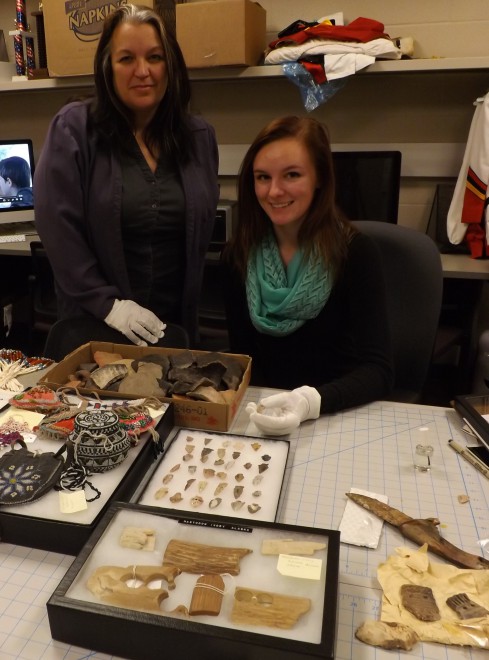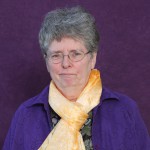
Dr. Rhonda Dass and student Stephanie Dixon work on cataloguing items from Erma Erikson’s collection.
On the day after Christmas in 2012, Erma Erikson ’67 was at Mankato’s Reconciliation Park, watching the dedication of a memorial bearing the names of the 38 Dakota men who were hanged in that same spot 150 years earlier.
She left the ceremony feeling like there was something she needed to do.
“It just seemed to me that there had been so many broken promises,” she says. “And I wanted to do a little something to improve on that.”
Erikson had a good idea about what her part in improving that could be. She had built up a collection of American Indian artifacts over the years, and she wanted to both learn more about the pieces she had purchased and to find a good home for them. She knew that some were newer, others older, and a few possibly not even American Indian made. She needed help identifying all of them—and then displaying them correctly as well. So Erikson called Minnesota State Mankato’s help desk, which referred her to Dr. Rhonda Dass, the director of the American Indian Studies program at the University.
Not long after that, Erikson figured out what she would be able to do. She gifted 1,200 of the artifacts she had collected to Minnesota State Mankato, along with funds to maintain the collection.
“I didn’t want to just have the collection,” Erikson explains. “I didn’t want it to be hidden in a dark closet somewhere. I wanted other people to be able to appreciate the artifacts, to learn from them. “I wanted to find a good home for these pieces,” she adds. “If there’s a better place for them to be, then that’s where I want them to be.”
One of the reasons Erikson felt good about giving the artifacts to Minnesota State Mankato is because she knew that students would have the opportunity to use her collection as part of their studies. The American Indian Studies program is part of the Department of Anthropology, which has a large collection of both precontact (related to indigenous people prior to contact with outside cultures) and archeological materials that students work with and learn from. Erikson’s gift expands the already-existing options for American Indian Studies students to directly experience and interact with important parts of Native history ranging from Paleoindian times, around 12,000 years ago, to the post-contact period. Right now, Dass’s students are working to catalogue each piece—a great opportunity to get hands-on experience with important artifacts.
But it was also important to Erikson to give a portion of the collection to her alma mater. Her family moved to Mankato in 1959, and her dad, Glenn Erikson, taught at the Wilson Lab School on campus. Although she moved to St. Louis after graduating and spent 40 years working for the federal government there, she was happy to return to her roots in 2012.
Her collection, which started because of her fascination with the American Indian heritage that surrounded her in her youth, grew when she came back to Mankato and started reading more about the U.S.-Dakota Conflict of 1862. But by then, she had realized that the items in her collection had more value if she shared them with others. She especially wanted to be able to share them with members of the native nations to whom they belonged.
Dass hopes to help her with that. She is already planning to mount an exhibit featuring the artifacts on campus as part
of American Indian Heritage Month next November. After that, she’d like to coordinate a travelling exhibit that will take the pieces to historical museums around the region.
“It’s important to share this with the whole community, not just with the University,”Dass says. “It’s so unusual to have a private collection come into public hands; this is a pretty big thing.”
Dass is impressed with the care Erikson has taken with her collection and with her commitment to finding the right place for it to reside. “She acts more like a caretaker than a collector,” Dass says. “She has been a gateway for these objects to come to the public.”

Speak Your Mind